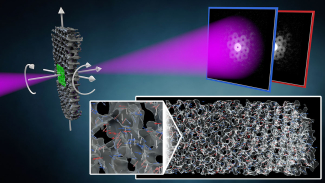Though microscopes have been in use for centuries, there is still much that we cannot see at the smallest length scales. Current microscopies range from the simple optical microscopes used in high school science classes, to x-ray microscopes that can image through visibly-opaque objects, to electron microscopes that use electrons instead of light to capture images of vaccines and viruses. However, there is a great need to see beyond the static structure of an object—to be able capture a nano- or biosystem functioning in real time, or to visualize the magnetic field on nanometer scales. A team of researchers from the STROBE Center have been working together to overcome these challenges. STROBE is an NSF Science and Technology Center led by JILA Fellow Margaret Murnane. The large and multidisciplinary collaboration included Chen-Ting Liao and the Kapteyn-Murnane group from JILA, the Miao and Osher groups from University of California Los Angeles, Ezio Iacocca from University of Colorado, Colorado Springs, David Shapiro and collaborators at Lawrence Berkley National Laboratory, and the Badding and Crespi groups from Pennsylvania State University. They developed and implemented a new method to use x-ray beams to capture the 3D magnetic texture in a material with very high 10-nanometer spatial resolution for the first time. They published their new technique and new scientific findings in Nature Nanotechnology.
Magnetic Lattices
The team investigated a nanostructured magnetic sample, consisting of tiny spheres of nickel, only ~30nm across, connected together by slender few-nm “necks” of nickel, that together form a structure called a magnetic metalattice. This complex nanostructured magnet is expected to produce swirling magnetic fields with topological spin textures that are far more complex than in a uniform magnet. However, until recently, there was no experimental method to measure the 3D spin texture at the nanoscale.
Using the x-ray synchrotron light source at the Lawrence Berkley National Laboratory, the researchers overcame these challenges. “When we illuminate the metalattice sample with a coherent (i.e. laser-like) x-ray beam, the light scatters from the sample to produce diffraction patterns on a detector,” explained co-first-author Chen-Ting Liao. “Then we scan the sample in 2D, change the polarizations of the light, and take the data again. Finally, we tilt and rotate the sample and repeat the measurements.” This creates a lot of data. “We collect about 800,000 distinct diffraction patterns, corresponding to several terabytes of data,” Liao added. “We then work with our collaborators to combine all these different diffraction patterns with state-of-the-art algorithms to reconstruct the full 3D vector image of the sample. This imaging technique is called 3D soft x-ray vector ptychography, and is the first general method to capture 3D spin texture at the nanoscale.”
Imaging spin textures is extremely important, as it can help physicists to better understand magnetism at a fundamental level, and to design more energy-efficient data storage, memory, and nanodevices. “We have known about the existence of magnetism for thousands of years, yet we still do not understand it at a fundamental level,” Murnane explained “Using electron microscopy, one can make a beautiful 2D image of a static spin-texture, but it is challenging to capture a full 3D image. Other scientists were able to capture a 3D image at a spatial resolution of about 100 nanometers, but they had to make assumptions about the sample to extract the 3D image.” With this new technique, researchers do not have to make any assumptions. “The rich physics in these nanostructures is only apparent when you can see the detailed spin textures with very high spatial resolution,” said Murnane. “The technique that STROBE developed is a real imaging science tour-de-force.
Hedgehogs and Anti-Hedgehogs
The topological magnetic spin textures that the researchers studied are called 3D magnetic skyrmions, or hedgehogs, due to their spiny shape in magnetic rotation. “We can think of magnetic hedgehogs as special 3D spin textures with a specific topology or shape,” Liao said. “When the topological charge is either +1 or -1, we get the equivalent of a magnetic monopole, which is a type of emergent magnetic quasi-particle. We also see anti-hedgehogs, where the 3D shape is an inverted hedgehog.” Studying hedgehogs has been difficult in the past, because this could only be done using computer simulations that had to make approximations. Thanks to the team's new technique, hedgehogs can now be visualized accurately, giving more useful data to researchers about how they interact and fluctuate within the lattice.
Armed with this new visualization technique, the team of researchers is excited to study spin textures further. “STROBE is developing tabletop setups and helping to commission national facilities that can capture the static and dynamic spin texture in materials,” explained Murnane. All algorithms developed for this data analysis will be open-sourced soon. Liao, Murnane, Miao, and the rest of the team will continue to share their results to help the community to drive advances in materials science. In this experiment, as with others, they found that collaboration is key for moving scientific progress forward.
To read the Full paper, go to: https://www.nature.com/articles/s41565-022-01311-0
Written by Kenna Hughes-Castleberry, JILA Science Communicator




